Search Results
Literacy Practice: Concept Map
Use this lesson plan and the provided template to have your students practice creating concept maps for any article. This literacy strategy boosts critical thinking and reading retention by having students organize information and connect important ideas, concepts and terms.
Slumbering water volcanoes
ooking for exciting and important applications of the phases of matter? Have students answer a set of questions relating changes in pressure to changes in states of matter. Learn about how hydrothermal explosions occur and the risk for these at Yellowstone National Park, all while discussing how geologists use core data to piece together geological history.
Making use of nature’s designs
New discoveries about the natural world can inspire the design of human-made objects. In this activity, students will learn about how the overlapping feathers on birds’ wings prompted engineers to reimagine the design of aircraft wings. Students will explain how this is an example of bioinspired design and then create their own bioinspired designs.
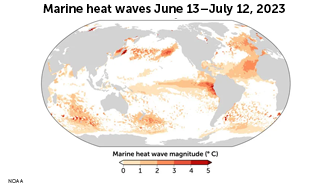
Analysis of marine heat waves
Global temperatures are at an all-time high due to the compounded effects of climate change and El Nino. Oceans around the world are warming at an alarming rate. In summer 2023, some 40 percent of the world’s oceans were affected by heat waves.
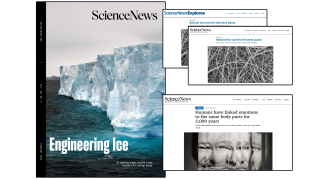
Emotional Responses and Nanonoodles
Check out these lesson plans paired to articles from the February issue of Science News to compare class survey data about where different emotional responses are felt in their bodies to two recent studies and have students apply concepts of scale and proportion while learning about how electrospinning turns dough into nanonoodles.
The real Inside Out: Emotional responses in the body
Use this activity to have your students collect, graph and analyze anonymous class data about where different emotional responses are felt in their bodies. Then compare the class data with the findings of two recent studies, one collecting modern data and the other drawing on ancient data. To better understand why people experience emotions in different areas of the body, have students explore the physiological chains of emotional responses.
Spinning spaghetti into nanonoodles
Take a seat, “angel hair” pasta. Scientists just fine-spun the world’s thinnest spaghetti. This nano-noodle recipe calls for modern electrospinning technology blended with creative culinary science — and, of course, a handful of pasta dough. Learn how electrospinning works by comparing the technique to the function of an old-fashioned spinning wheel, at the same time answering questions about polymers and connecting chemistry concepts to textile manufacturing.
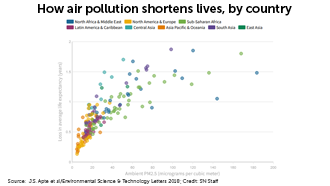
Air pollution and human health
In August of 2018, scientists published research showing how air pollution shaves off about a year on average from human life expectancy. In more polluted regions of Asia and Africa, lives are shortened by 1.5–2 years on average. Loss in life expectancy rises with increasing concentrations of fine particulate air pollution (PM2.5).
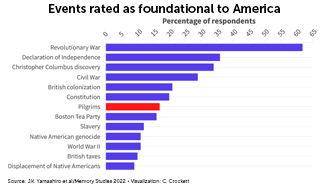
- Exercise type:Graph of the Week
- Topic:Science & Society
- Category:Diversity in STEM
- Category:Literacy Practices
How do we remember events in history?
According to a 2022 study, people in the United States often included Thanksgiving as an event important to the country’s foundation along with the Revolutionary War, the Declaration of Independence, Christopher Columbus’s “discovery” of the Americas, the Civil War and British colonization. But the events in most people’s narrative of the first Thanksgiving run contrary to history. Thanksgiving myths abound because their memory is rooted in story. While such origin stories tend to unify people, they sometimes misrepresent the truth. Tidy tales of history sometimes appear in books and museum exhibits, preserving the group narrative and identity.
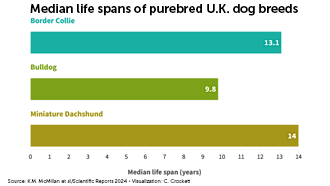
Life expectancy of dog breeds
In February 2024, a team of researchers collected 580,000 records on domestic dogs in the United Kingdom. On average, dogs live roughly 10 to 14 years. Overall, dogs from pure breeds that are small and have a long nose seemed to have longer life spans. But some flat-faced dogs, such as Tibetan mastiffs, had an average life span of 13 years.
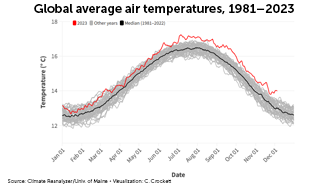
Hottest year on record
Since temperature record-keeping began 150 years ago, the 12-month period from November 2022 through October 2023 was the hottest on record until temperatures in 2024 exceeded those in 2023. The heat raised sea surface temperatures, melted sea ice and endangered human health.
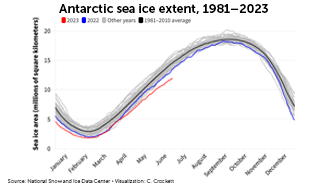
Antarctic sea ice
In 2023, the expanse of floating ice encircling Antarctica hit record lows throughout the year. Scientists expect dramatic declines in sea ice at Earth’s other pole but hadn’t observed major changes in the Antarctic until the last few years.